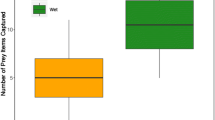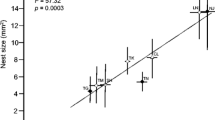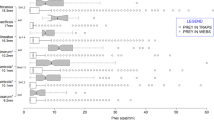Abstract
Latitude, rainfall, and productivity have been shown to influence social organisation and level of sociality in arthropods on large geographic scales. Social spiders form permanent group-living societies where they cooperate in brood care, web maintenance, and foraging. Sociality has evolved independently in a number of unrelated spider genera and may reflect convergent evolutionary responses to common environmental drivers. The genus Anelosimus contains a third of approximately 25 described permanently social spider species, eight to nine species that all occur in the Americas. To test for environmental correlates of sociality in Anelosimus across the Americas, we used logistic regression to detect effects of annual rainfall, productivity, and precipitation seasonality on the relative likelihood of occurrence of social and non-social Anelosimus spiders. Our analyses show that social species tend to occur at higher annual rainfall and productivity than non-social species, supporting the hypothesised effects of these environmental variables on the geographical distribution of social species. We did not find support for the hypothesis that permanently social species occur in areas with low precipitation seasonality. High annual precipitation and, to less extent, high productivity favour the occurrence of permanently group-living Anelosimus spiders relative to subsocial and solitary species. These results are partially consistent with previous findings for the Old World spider genus Stegodyphus, where a link between high habitat productivity and sociality was also found. Unlike Anelosimus, however, Stegodyphus typically occur in dry habitats negating a general importance of high precipitation for sociality. Sociality in spiders thus seems to be strongly linked to productivity, probably reflecting the need for relatively high availability of large prey to sustain social colonies.



Similar content being viewed by others
References
Agnarsson I (2006) A revision of the New World eximius lineage of Anelosimus (Araneae, Theridiidae) and a phylogenetic analysis using worldwide exemplars. Zool J Linn Soc 146(4):453–593. doi:10.1111/j.1096-3642.2006.00213.x
Agnarsson I (2012a) A new phylogeny of Anelosimus and the placement and behavior of Anelosimus vierae n. sp from Uruguay (Araneae: Theridiidae). J Arachnol 40(1):78–84
Agnarsson I (2012b) Systematics of new subsocial and solitary Australasian Anelosimus species (Araneae : Theridiidae). Invertebr Syst 26(1):1–16. doi:10.1071/IS11039
Agnarsson I, Aviles L, Coddington JA, Maddison WP (2006a) Sociality in theridiid spiders: repeated origins of an evolutionary dead end. Evolution 60(11):2342–2351
Agnarsson I, Barrantes G, May-Collado LJ (2006b) Notes on the biology of Anelosimus l Levi, 1963 (Theridiidae, Araneae)—evidence for an evolutionary reversal to a less social state. J Nat Hist 40(47–48):2681–2687. doi:10.1080/00222930601110752
Agnarsson I, Kuntner M, Coddington JA, Blackledge TA (2010) Shifting continents, not behaviours: independent colonization of solitary and subsocial Anelosimus spider lineages on Madagascar (Araneae, Theridiidae). Zool Scr 39(1):75–87. doi:10.1111/j.1463-6409.2009.00406.x
Aviles L (1997) Causes and consequences of cooperation and permanent-sociality in spiders. In: Choe JC, Crespi BJ (eds) The evolution of social behaviour in insects and arachnids. Cambridge University Press, Cambridge, pp 476–498
Avilés L, Harwood G (2012) A quantitative index of sociality and its application to group-living spiders and other social organisms. Ethology 118(12):1219–1229. doi:10.1111/eth.12028
Avilés L, Agnarsson I, Salazar PA, Purcell J, Iturralde G, Yip EC, Powers KS, Bukowski TC (2007) Natural history miscellany: altitudinal patterns of spider sociality and the biology of a new midelevation social Anelosimus species in Ecuador. Am Nat 170(5):783–792. doi:10.1086/521965
Bilde T, Lubin Y (2011) Group living in spiders: cooperative breeding and coloniality. In: Herberstein ME (ed) Spider behaviour: flexibility and versatility. Cambridge University Press, Cambridge, pp 275–306
Bilde T, Lubin Y, Smith D, Schneider JM, Maklakov AA (2005) The transition to social inbred mating systems in spiders: role of inbreeding tolerance in a subsocial predecessor. Evolution 59(1):160–174
Borer ET, Seabloom EW, Tilman D (2012) Plant diversity controls arthropod biomass and temporal stability. Ecol Lett 15(12):1457–1464. doi:10.1111/ele.12006
Brach V (1977) Anelosimus studiosus (Araneae-Theridiidae) and evolution of quasi-sociality in theridiid spiders. Evolution 31(1):154–161
Clark Labs (1998) IDRISI 2.0. Clark University; Worcester, Massachusetts, US. http://edit.csic.es/Soil-Vegetation-LandCover.html.
Clarke A, Gaston KJ (2006) Climate, energy and diversity. Proc R Soc B Biol Sci 273(1599):2257–2266. doi:10.1098/rspb.2006.3545
Davies B, Krebs R, West A (2012) Living in groups. In: An introduction to behavioural ecology. Wiley, Chichester, UK, pp 147–177
Diniz-Filho JAF, Bini LM (2005) Modelling geographical patterns in species richness using eigenvector-based spatial filters. Glob Ecol Biogeogr 14(2):177–185. doi:10.1111/j.1466-822X.2005.00147.x
Franklin J (2009) Mapping species distributions. Ecology, biodiversity and conservation. Cambridge University Press, Cambridge
GBIF (2012) Biodiversity occurrence data accessed through GBIF data portal. Museum of Comparative Zoology. Harvard University. http://data.gbif.org. Accesssed 14 June 2012
Guevara J, Aviles L (2007) Multiple techniques confirm elevational differences in insect size that may influence spider sociality. Ecology 88(8):2015–2023. doi:10.1890/06-0995.1
Guevara J, Avilés L (2011) Influence of body size and level of cooperation on the prey capture efficiency of two sympatric social spiders exhibiting an included niche pattern. Funct Ecol 25(4):859–867. doi:10.1111/j.1365-2435.2011.01843.x
Guevara J, Gonzaga MO, Vasconcellos-Neto J, Avilés L (2011) Sociality and resource use: insights from a community of social spiders in Brazil. Behav Ecol 22(3):630–638. doi:10.1093/beheco/arr022
Janzen DH, Schoener TW (1968) Differences in insect abundance and diversity between wetter and drier sites during a tropical dry season. Ecology 49(1):96–110
Jetz W, Rubenstein DR (2011) Environmental uncertainty and the global biogeography of cooperative breeding in birds. Curr Biol 21(1):72–78. doi:10.1016/j.cub.2010.11.075
Johnson JB, Omland KS (2004) Model selection in ecology and evolution. Trends Ecol Evol 19(2):101–108
Jones TC, Riechert SE (2008) Patterns of reproductive success associated with social structure and microclimate in a spider system. Anim Behav 76:2011–2019. doi:10.1016/j.anbehav.2008.07.033
Jones TC, Riechert SE, Dalrymple SE, Parker PG (2007) Fostering model explains variation in levels of sociality in a spider system. Anim Behav 73(1):195–204
Jonsson M, Yeates GW, Wardle DA (2009) Patterns of invertebrate density and taxonomic richness across gradients of area, isolation, and vegetation diversity in a lake-island system. Ecography 32(6):963–972. doi:10.1111/j.1600-0587.2009.05784.x
Kaspari M (2005) Global energy gradients and size in colonial organisms: worker mass and worker number in ant colonies. Proc Natl Acad Sci U S A 102(14):5079–5083. doi:10.1073/pnas.0407827102
Kaspari M, Vargo EL (1995) Colony size as a buffer against seasonality: Bergmann's rule in social insects. Am Nat 145(4):610–632
Kriticos DJ, Webber BL, Leriche A, Ota N, Macadam I, Bathols J, Scott JK (2012) CliMond: global high-resolution historical and future scenario climate surfaces for bioclimatic modelling. Methods Ecol Evol 3(1):53–64. doi:10.1111/j.2041-210X.2011.00134.x
Kullmann EJ (1972) Evolution of social behavior in spiders (Araneae; Eresidae and Theridiidae). Am Zool 12(3):419–426. doi:10.1093/icb/12.3.419
Lomolino MV, Riddle BR, Brown JH (2006) The geography of communities. In: Biogeography. Sinauer, Sunderland, pp 97–138
Lubin Y, Bilde T (2007) The evolution of sociality in spiders. In: John M (ed) Advances in the study of behavior, vol 37. Academic Press, San Diego, pp 83–145. doi:10.1016/S0065-3454(07)37003-4
Majer M, Svenning JC, Bilde T (2013) Habitat productivity constraints the distribution of social spiders across continents - case study of the genus Stegodyphus. Front Zool 10:9
Marques ESA, Vasconcelos-Netto J, Mello MB (1998) Life history and social behavior of Anelosimus jabaquara and Anelosimus dubiosus (Araneae, Theridiidae). J Arachnol 26(2):227–237
Nagelkerke NJD (1991) A note on a general definition of the coefficient of determination. Biometrika 78(3):691–692. doi:10.1093/biomet/78.3.691
Nentwig W (1985) Social spiders catch larger prey: a study of Anelosimus eximius (Araneae: Theridiidae). Behav Ecol Sociobiol 17(1):79–85. doi:10.1007/bf00299433
Plateaux-Quènu C, Horel A, Roland C (1997) A reflection on social evolution in two different groups of arthropods: halictine bees (Hymenoptera) and spiders (Arachnida). Ethol Ecol Evol 9(2):183–196. doi:10.1080/08927014.1997.9522897
Platnick NI (2013) The world spider catalog, version 13.5. American Museum of Natural History. http://research.amnh.org/iz/spiders/catalog. Accessed 30 Sept 2012
Powers KS, Aviles L (2007) The role of prey size and abundance in the geographical distribution of spider sociality. J Anim Ecol 76(5):995–1003. doi:10.1111/j.1365-2656.2007.01267.x
Pruitt JN, Riechert SE, Jones TC (2008) Behavioural syndromes and their fitness consequences in a socially polymorphic spider, Anelosimus studiosus. Anim Behav 76(3):871–879. doi:10.1016/j.anbehav.2008.05.009
Pruitt JN, Demes KW, Dittrich-Reed DR (2011) Temperature mediates shifts in individual aggressiveness, activity level, and social behavior in a spider. Ethology 117(4):318–325. doi:10.1111/j.1439-0310.2011.01877.x
Pruitt JN, Oufiero CE, Aviles L, Riechert SE (2012) Iterative evolution of increased behavioral variation characterizes the transition to sociality in spiders and proves advantageous. Am Nat 180(4):496–510. doi:10.1086/667576
Purcell J (2011) Geographic patterns in the distribution of social systems in terrestrial arthropods. Biol Rev 86(2):475–491. doi:10.1111/j.1469-185X.2010.00156.x
Purcell J, Avilés L (2007) Smaller colonies and more solitary living mark higher elevation populations of a social spider. J Anim Ecol 76(3):590–597. doi:10.1111/j.1365-2656.2007.01228.x
Purcell J, Avilés L (2008) Gradients of precipitation and ant abundance may contribute to the altitudinal range limit of subsocial spiders: insights from a transplant experiment. Proc R Soc B Biol Sci 275(1651):2617–2625. doi:10.1098/rspb.2008.0582
Purcell J, Vasconcellos-Neto J, Gonzaga MO, Fletcher JA, Avilés L (2012) Spatio-temporal differentiation and sociality in spiders. PLoS ONE 7(4):e34592. doi:10.1371/journal.pone.0034592
R Development Core Team (2011) R: a language and environment for statistical computing. 2.14.2 edn. R Foundation for Statistical Computing, Vienna
Rangel TF, Diniz-Filho JAF, Bini LM (2010) SAM: a comprehensive application for spatial analysis in macroecology. Ecography 33(1):46–50. doi:10.1111/j.1600-0587.2009.06299.x
Rehan SM, Schwarz MP, Richards MH (2011) Fitness consequences of ecological constraints and implications for the evolution of sociality in an incipiently social bee. Biol J Linnean Soc 103(1):57–67. doi:10.1111/j.1095-8312.2011.01642.x
Riechert SE (1985) Why do some spiders cooperate? Agelena consociata, a case study. Fla Entomol 68(1):105–116
Riechert SE, Jones TC (2008) Phenotypic variation in the social behaviour of the spider Anelosimus studiosus along a latitudinal gradient. Anim Behav 75(6):1893–1902
Riechert SE, Roeloffs R, Echternacht AC (1986) The ecology of the cooperative spider Agelena consociata in equatorial Africa (Araneae, Agelenidae). J Arachnol 14(2):175–191
Schwarz M, Silberbauer LX, Hurst PS (1997) Intrinsic and extrinsic factors associated with social evolution in allodapine bees. In: Choe JC, Crespi BJ (eds) The evolution of social behaviour in insects and arachnids. Cambridge University Press, Cambridge
Schwarz MP, Richards MH, Danforth BN (2007) Changing paradigms in insect social evolution: insights from halictine and allodapine bees. Annu Rev Entomol 52(1):127–150. doi:10.1146/annurev.ento.51.110104.150950
Whitehouse MEA, Lubin Y (2005) The functions of societies and the evolution of group living: spider societies as a test case. Biol Rev 80(3):347–361
Wolda H (1978) Seasonal fluctuations in rainfall, food and abundance of tropical insects. J Anim Ecol 47(2):369–381
Yanega D (1997) Demography and sociality in halictine bees (Hymenoptera: Halictidae). In: Choe J, Crespi BJ (eds) The evolution of social behavior in insects and arachnids. Cambridge University Press, Cambridge, pp 293–315
Acknowledgments
This study was supported by grants from The Danish Council for Independent Research to TB (grant number 09-065911) and a travel grant from the Oticon foundation to MM. We would like to thank Laura J. May-Collado for her help with entering the species occurrence data, and Brody Sandel and Michelle Greve for their help with the statistical computation. The authors would like to greatly thank the permanent and visiting members of Ingi Agnarsson's lab for their kind and friendly reception and academic discussion. Constructive comments from three anonymous reviewers helped improve the manuscript.
Author information
Authors and Affiliations
Corresponding author
Additional information
Communicated by: Sven Thatje
Electronic supplementary material
Below is the link to the electronic supplementary material.
ESM 1
Boxplots of environmental gradients representing the underlying hypotheses for the distribution patterns of American Anelosimus species, for solitary (20 records), subsocial (81 records), transitionally-social (239 records) and social species locality records (93 records). The extremes, the inter-quartile range, and the median are shown for annual precipitation, habitat productivity (GVI) and precipitation seasonality. Scales differ for each of the three variables (see Methods). (PDF 220 kb)
ESM 2
Performance of logistic regression models predicting social vs. transitionally-social Anelosimus species occurrences (93 social: 239 transitionally-social). The Akaike scores (AIC), differences (∂AIC) and weights of each model (w i ) are given. Four spatial filters were included in all the models to account for spatial autocorrelation in the data. Abbreviations used for the predictors are: GVI for vegetation index, PREmean for mean annual precipitation, PREseas for precipitation seasonality. In bold the Akaike weights of the best supported models. (PDF 209 kb)
ESM 3
Multimodel coefficient estimates for all three environmental predictors across the models (Appendix 2). Given are the coefficient estimates based on the standardised coefficient and model weights (Multimodel β = Std. β*wi), odds of being more social (outcome 1 in all models), and the relative coefficient support in each model set based on the sums the Akaike weights of the models containing each predictor (Appendix 2). (PDF 203 kb)
ESM 4
Model coefficients from each of the models from Table 2 contrasting social and non-social Anelosimus spp (a); and social vs. subsocial Anelosimus spp (b). (PDF 236 kb)
ESM 5
Correlation matrices of predictor variables in the dataset of Anelosimus occurrences. (PDF 206 kb)
ESM 6
Variance inflation factors (VIFs) for predictors in the dataset of Anelosimus occurrences (PDF 136 kb)
Rights and permissions
About this article
Cite this article
Majer, M., Agnarsson, I., Svenning, JC. et al. Social spiders of the genus Anelosimus occur in wetter, more productive environments than non-social species. Naturwissenschaften 100, 1031–1040 (2013). https://doi.org/10.1007/s00114-013-1106-6
Received:
Revised:
Accepted:
Published:
Issue Date:
DOI: https://doi.org/10.1007/s00114-013-1106-6




